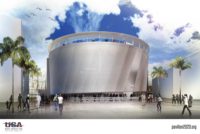Fentress Architects to Design U.S. Pavilion at 2020 World Expo in Dubai

Santiago Calatrava’s UAE Pavilion for the 2020 World Expo in Dubai
Rendering courtesy Santiago Calatrava
Architects & Firms
Denver-based Fentress Architects will design the U.S. pavilion at the 2020 World Expo in Dubai. The announcement was made by Big Things Group (BTG), the fund-raising and sponsorship firm chosen by the State Department to build and operate the privately funded pavilion.
The architecture firm’s founder, Curtis Fentress, tells RECORD that he is personally involved in the project, adding, “I spent half of today working on it. Right now we’re developing the program.” Renderings, he says, are still “a while down the road.” With the theme “What Moves You,” the U.S. pavilion will focus on advances in transportation, as well as other things that move you, which, Fentress says, could include “medical devices that move you, such as high-tech prostheses.”
Fentress and its partners (Giuliani Associates Architects; George P. Johnson Experience Marketing; Onuma, Inc.; Thornton Tomasetti; and Syska Hennessy Group) will only get paid if BTG raises the necessary funds. (A BTG spokesman declined to talk about construction budgets, or anything else, referring this reporter to a somewhat elliptical press release.) “I’ve heard this hasn’t been a very successful venture for the previous architects,” says Fentress. But, he adds, “I feel very confident they’re going to raise the money, based on the responses they’ve been getting. We’ll see if they wrap that up in the next 90 days.”
Under U.S. law, the State Department is barred from spending public funds on Expo pavilions, absent a specific appropriation by Congress. That has created a series of public-diplomacy disasters. The U.S. was a no-show at the 2000 expo in Hanover, Germany, and depended on Toyota sponsorship for its pavilion in Aichi, Japan, in 2005. The pavilion in Shanghai in 2010 was widely considered an embarrassment, given the prominent mentions of its corporate sponsors. The Milan pavilion was successful, design-wise. But the non-profit that built and ran that pavilion declared bankruptcy in 2017, leaving members of the design team out of luck. Manhattan Architect James Biber says he is owed more than half of his firm’s $2 million fee, and that the odds of collecting, years after the expo closed, are minuscule.
Asked if he has any advice for Fentress, Biber says, “Insist on full payment before the pavilion opens.” (He also provided a number of suggestions for keeping people moving through the pavilion, which is expected to attract some 6 million visitors from October 20, 2020, to April 10, 2021, with some 180 countries represented at the Expo.)
The theme of the 2020 Expo is the predictably vague “Connecting Minds, Creating the Future.” Three sub-themes—Mobility, Sustainability and Opportunity—will be explored in central pavilions, designed, respectively, by Foster + Partners, Grimshaw, and Bjarke Ingels Group. The fair, at the southwestern edge of Dubai, was master planned by an HOK-led team that included Populous and Arup and was inspired by the layout of a traditional Arab marketplace, or souk.
Ground was broken last December on the host country’s lavish pavilion, designed by Santiago Calatrava, with a roof inspired by the shape of a falcon’s wing. Other countries (some 180 total will be represented at the Expo) began breaking ground in May. Of the compressed schedule for the U.S. pavilion, Fentress says, “I think we’ll make it in the nick of time.”


